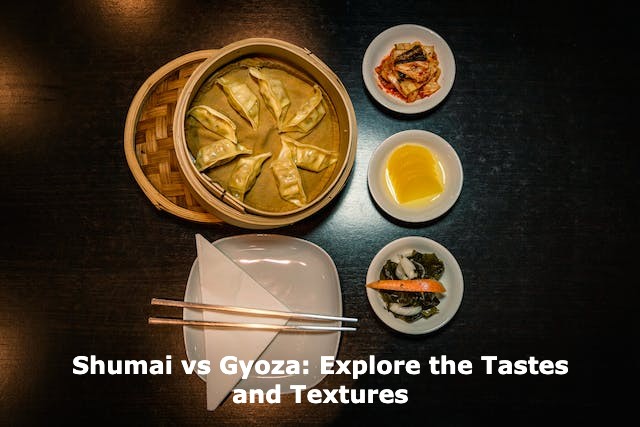
Shumai vs Gyoza: Explore the Tastes and Textures
Shumai vs gyoza are both delicious Asian dumplings, but they originate from different culinary traditions and have distinct characteristics in terms of ingredients, preparation, and presentation. Here’s a breakdown of the key differences between Shumai vs Gyoza:
1. Origin:
- Shumai: Origin of Shumai vs Gyoza are different. Shumai, also known as shaomai, is a type of Chinese dumpling that has been adopted and adapted by various East Asian cuisines, including Chinese, Japanese, and Filipino. It is believed to have originated in China.
- Gyoza: Gyoza is a Japanese dumpling, although it has its roots in Chinese cuisine. The Japanese adapted and popularized gyoza, giving it its unique characteristics.
2. Wrapper:
- Shumai: Shumai typically has a thin, open-faced wrapper made from unleavened dough. The top of the shumai is often left open, revealing the filling.
- Gyoza: Gyoza has a thinner and more delicate wrapper that is usually made with a mixture of wheat flour and water. Gyoza wrappers are round and folded, enclosing the filling completely.
3. Filling:
- Shumai: Shumai filling usually consists of a mixture of ground meat (such as pork or shrimp), vegetables, and seasonings. The filling is often coarsely chopped and may include ingredients like water chestnuts or bamboo shoots.
- Gyoza: Gyoza filling typically contains a mixture of ground meat (often pork or chicken), finely chopped vegetables (such as cabbage, garlic, and green onions), and seasonings. The filling is finely minced and tightly packed.
4. Shape:
- Shumai: Shumai is traditionally shaped like an open dumpling cup, with the edges of the wrapper folded upwards, exposing the filling.
- Gyoza: Gyoza has a closed, crescent or half-moon shape, achieved by folding and pleating the edges of the wrapper. The filling is completely enclosed within the wrapper. In comparison of shape both Shumai vs Gyoza are quite similar.
5. Cooking Method:
- Shumai: Shumai is often steamed, although it can also be pan-fried or deep-fried. Steamed shumai is a popular dim sum dish.
- Gyoza: Gyoza is commonly prepared by pan-frying and then steaming, resulting in a crispy bottom and a tender, juicy interior. It can also be boiled or deep-fried.
6. Dipping Sauce:
- Shumai: Shumai is often served with a dipping sauce that may include soy sauce, rice vinegar, and sometimes sesame oil. Chilli oil or hot mustard can be added for extra flavor.
- Gyoza: Gyoza is typically accompanied by a dipping sauce made with soy sauce, rice vinegar, and sometimes garlic or sesame oil. Some variations may also include chili oil or grated ginger.
Conclusion:
In summary, while Shumai vs Gyoza both belong to the category of Asian dumplings, they have distinctive features in terms of origin, wrapper, filling, shape, cooking method, and accompanying sauces. Therefore, each dumpling offers a unique culinary experience, reflecting the diversity and creativity within Asian cuisines.
FAQs on Shumai vs Gyoza
What is the primary distinction between Shumai and Gyoza?
Shumai vs Gyoza differ primarily in their wrappers and cooking methods. Shumai typically features an open-top, thin, translucent wrapper and is often steamed, while Gyoza has a thicker, sealed wrapper and is commonly pan-fried and steamed.
How do the wrappers of Shumai and Gyoza affect their textures?
The thin and translucent wrapper of Shumai results in a delicate and moist texture, while the thicker, doughier wrapper of Gyoza contributes to a combination of crispy and soft textures, especially when pan-fried.
Are the fillings of Shumai vs Gyoza similar or distinct?
Both dumplings share a common concept of a filling made with ground meat, vegetables, and seasonings. However, the specific ingredients vary; Shumai often includes a combination of pork and shrimp, whereas Gyoza commonly incorporates ground pork, cabbage, garlic, and other seasonings.
Can Shumai and Gyoza be considered interchangeable in recipes?
Due to their differing wrappers and textures, Shumai vs Gyoza are not always interchangeable in recipes. The choice between them depends on the desired texture, flavor profile, and cooking method.
Are there cultural or regional variations in the preparation of Shumai vs Gyoza?
Yes, there are cultural and regional variations in the preparation of both Shumai vs Gyoza. For instance, Chinese Shumai may differ from Japanese or Southeast Asian varieties, and regional preferences can influence the ingredients and cooking techniques used.
Are there specific sauces or accompaniments that pair better with Shumai or Gyoza?
The choice of sauces and accompaniments can enhance the flavors of Shumai and Gyoza. Shumai often pairs well with soy-based or chili sauces, while Gyoza is commonly served with a dipping sauce that includes soy sauce, vinegar, and sometimes chili oil.
